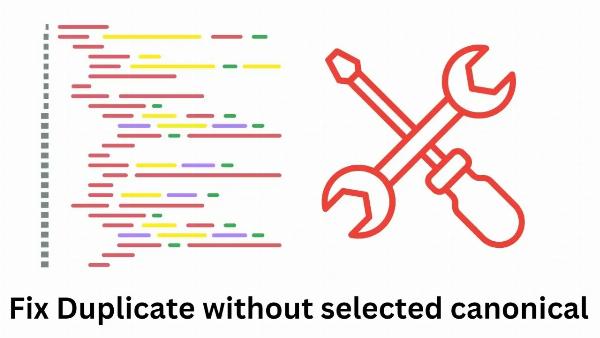Duplicate Without User Selected Canonical

Strong 8k brings an ultra-HD IPTV experience to your living room and your pocket.
Duplicate without user-selected canonical is when different or slightly different URLs lead to the same web page, but doesn’t show which URL is the real one. For example, I entered www.anyblogsview.com in the search bar and landed on the website I intended. And you, in some other corner of the world, typed https://anyblogsview.com and landed on the same web page.
✍️ From Core Web Vitals to structured data, every technical detail impacts your ranking potential. Learn actionable steps in our comprehensive resource on technical SEO best practices to future-proof your site and maximize organic traffic growth.
But, two different URLs leading to the same page might seem confusing, right? The same happens with search engine bots. When they find two different URLs leading to the same page, they get confused, and in the confusion of “which one to rank first”, they might not rank any and this might be a great loss for your website.
Additionally, even the users get confused and find it hard to trust either of them. Telling the users and the search engines which one of them is the original can help them crawl to your website and increase the visibility of your website.
You might wonder why this happens. Or, how does this happen? We’re here to let you know. Not every person is a master of creating great websites and handling them. Some reasons that this issue exists are-
Some website-building tools make it hard to post content.
People aren’t trained or taught about how to post content and select the version.
Accessing the same page through different search engines or platforms results in this.
But, every problem has a solution, this has one too, or maybe two?
What Is The Meaning Of Canonical
Canonical means “to rule.” Here, canonical means the one who tells you which page is the original one. Terms like “canonical tag” or “canonical URL” are the terms that give you information about the original page or the original URL. They help the search engines in finding the correct URL and giving it the credit.
So, to help users trust you and let the search engines crawl to your web page through the correct URL, you use a canonical tag. Canonical tags are just some simple codes that you need to insert in your posts or web page when you’re about to upload them. A good thing about it?
The same code is inserted in every post, you don’t need to create a different one for any other page. This helps those web pages differentiate themselves from the crowd of duplicates. You can select the URL that you want to appear as the original and give it the badge of a boss.
Why Does Duplicate Without User-Selected Canonical Happen
The case of a duplicate without user-selected canonical tags may confuse many, but you, don’t be confused. Here’s why it happens-
People Don’t Know About It
Everyone wants to run a website and put effort into growing it and gaining visibility, but not all of them try to put effort into gaining knowledge about a website, the small points and what are the important things to take special care of. One of them appears to be a canonical tag, but not everyone seems to know about it and the confusion created by its absence.
Technical Problems
Suppose you hired a person to build a website, or you used a tool to build your website, they make it easy to post content but they forget about canonical tags. The not-so-expert people afterwards either find it hard to put a canonical tag or don’t give much importance to it.
Sharing Content Without Knowing The Original URL
When people share your content or a web page link without informing you or neglecting the original URL, syndication happens. It also happens when search engine bots make mistakes while showing it to the users and through plugins.
There are still many reasons that are known and unknown as well. Search engines are full of mysteries and surprises, and this too is one of them.
How To Fix It On WordPress
It might look difficult, but it’s quite simple; even a child with basic internet knowledge can do this if instructed. Just follow the instructions and we’ve got you covered!
Firstly, install a plugin on WordPress that you trust the most and find reliable, such as Yoast SEO. That plugin should have an easy interface so that you can easily handle and navigate through it. Then, open the settings of the SEO plugin and enter the domain format that you want the webpage to appear for.
Afterwards, whenever you are creating a post, editing or updating it, you can just scroll down to the SEO settings, select the canonical URL and enter. That’s it! To be a step ahead, and to ensure that it’s correct in the future, keep a check on it and perform regular audits.
How To Fix It In HTML Website
This one will need you to insert a small code, but don’t worry, we’re here to guide you.
Open the HTML code of your website management tool or text editor and click on the
section of the HTML code. Here, you’ll be able to insert the canonical tag for your page. The code you’ll use is-Enter the URL of the original web page in the place of the one that was used as an example.
To find out if the code has been implemented or not, use Google Search Console to check if the original one is getting prioritized over the duplicates.
Conclusion
Duplicate Without User-Selected Canonical Tags can appear as a serious issue and it might even be a threat to your website’s visibility and ranks. To sort this issue, follow this blog to get more information about this issue and solve it.
The mentioned steps can help you easily put a canonical tag on each web page and help appear as original. By fixing, the original page URL gets the credit and you emerge as an expert too. So, don’t wait anymore and fix yours at the earliest!
Note: IndiBlogHub features both user-submitted and editorial content. We do not verify third-party contributions. Read our Disclaimer and Privacy Policyfor details.





